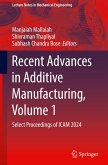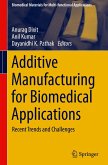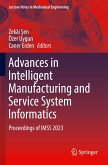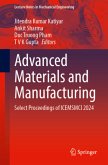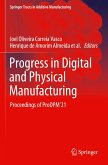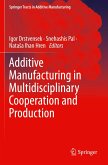Additive Manufacturing Teaching and Training Case Studies
Education Strategies for Additive Manufacturing
Herausgegeben:Pei, Eujin; Monzón, Mario; Bernard, Alain; Gibson, Ian
Additive Manufacturing Teaching and Training Case Studies
Education Strategies for Additive Manufacturing
Herausgegeben:Pei, Eujin; Monzón, Mario; Bernard, Alain; Gibson, Ian
- Gebundenes Buch
- Merkliste
- Auf die Merkliste
- Bewerten Bewerten
- Teilen
- Produkt teilen
- Produkterinnerung
- Produkterinnerung
This textbook provides a wealth of information for researchers, teachers and educators, offering knowledge and practical insights to navigate the intricacies of training and teaching the use of Additive Manufacturing. Featuring contributions from world-leading experts, each chapter delves into specialized areas such as integrating AM practices in academia, applications in special needs education, and teaching design for AM while balancing creativity and functionality. Real-world case studies provide invaluable lessons for teaching AM to metal forming students, empowering the workforce through…mehr
Andere Kunden interessierten sich auch für
![Recent Advances in Additive Manufacturing, Volume 1 Recent Advances in Additive Manufacturing, Volume 1]() Recent Advances in Additive Manufacturing, Volume 1416,99 €
Recent Advances in Additive Manufacturing, Volume 1416,99 €![Recent Advances in Additive Manufacturing, Volume 2 Recent Advances in Additive Manufacturing, Volume 2]() Recent Advances in Additive Manufacturing, Volume 2166,99 €
Recent Advances in Additive Manufacturing, Volume 2166,99 €![Additive Manufacturing for Biomedical Applications Additive Manufacturing for Biomedical Applications]() Additive Manufacturing for Biomedical Applications151,99 €
Additive Manufacturing for Biomedical Applications151,99 €![Advances in Intelligent Manufacturing and Service System Informatics Advances in Intelligent Manufacturing and Service System Informatics]() Advances in Intelligent Manufacturing and Service System Informatics167,99 €
Advances in Intelligent Manufacturing and Service System Informatics167,99 €![Advanced Materials and Manufacturing Advanced Materials and Manufacturing]() Advanced Materials and Manufacturing166,99 €
Advanced Materials and Manufacturing166,99 €![Progress in Digital and Physical Manufacturing Progress in Digital and Physical Manufacturing]() Progress in Digital and Physical Manufacturing211,99 €
Progress in Digital and Physical Manufacturing211,99 €![Additive Manufacturing in Multidisciplinary Cooperation and Production Additive Manufacturing in Multidisciplinary Cooperation and Production]() Additive Manufacturing in Multidisciplinary Cooperation and Production136,99 €
Additive Manufacturing in Multidisciplinary Cooperation and Production136,99 €-
-
-
This textbook provides a wealth of information for researchers, teachers and educators, offering knowledge and practical insights to navigate the intricacies of training and teaching the use of Additive Manufacturing. Featuring contributions from world-leading experts, each chapter delves into specialized areas such as integrating AM practices in academia, applications in special needs education, and teaching design for AM while balancing creativity and functionality. Real-world case studies provide invaluable lessons for teaching AM to metal forming students, empowering the workforce through collaborative training initiatives and revolutionizing education through distance learning.
With a focus on pedagogical excellence, this book introduces innovative teaching methodologies, digital immersion in virtual reality, and metacognitive-driven training approaches to enhance AM education. From sustainability considerations to medical applications, each chapter offers a unique perspective, ensuring a holistic understanding of AM's potential. Whether you are a seasoned professional or a newcomer to the field, this book equips readers with the strategies and knowledge to excel in Additive Manufacturing education and practice, bridging the gap between theory and application in this rapidly evolving domain.
With a focus on pedagogical excellence, this book introduces innovative teaching methodologies, digital immersion in virtual reality, and metacognitive-driven training approaches to enhance AM education. From sustainability considerations to medical applications, each chapter offers a unique perspective, ensuring a holistic understanding of AM's potential. Whether you are a seasoned professional or a newcomer to the field, this book equips readers with the strategies and knowledge to excel in Additive Manufacturing education and practice, bridging the gap between theory and application in this rapidly evolving domain.
Produktdetails
- Produktdetails
- Verlag: Springer / Springer Nature Switzerland / Springer, Berlin
- Artikelnr. des Verlages: 978-3-031-94546-5
- Seitenzahl: 432
- Erscheinungstermin: 31. August 2025
- Englisch
- Abmessung: 241mm x 160mm x 28mm
- Gewicht: 887g
- ISBN-13: 9783031945465
- ISBN-10: 3031945468
- Artikelnr.: 73956463
- Herstellerkennzeichnung
- Springer-Verlag KG
- Sachsenplatz 4-6
- 1201 Wien, AT
- ProductSafety@springernature.com
- Verlag: Springer / Springer Nature Switzerland / Springer, Berlin
- Artikelnr. des Verlages: 978-3-031-94546-5
- Seitenzahl: 432
- Erscheinungstermin: 31. August 2025
- Englisch
- Abmessung: 241mm x 160mm x 28mm
- Gewicht: 887g
- ISBN-13: 9783031945465
- ISBN-10: 3031945468
- Artikelnr.: 73956463
- Herstellerkennzeichnung
- Springer-Verlag KG
- Sachsenplatz 4-6
- 1201 Wien, AT
- ProductSafety@springernature.com
Eujin PEI is a Full Professor specializing in Additive Manufacturing and Director of Product Design Engineering and Co-Director for the Centre for Digital Manufacturing at Brunel University of London. He previously served as Associate Dean, and Director of Postgraduate Research. A Chartered Engineer, Chartered Environmentalist and Chartered Technological Product Designer, Eujin is a Fellow of the Institution of Engineering Designers, actively shaping engineering education and policy. He is the Editor-in-Chief of Progress in Additive Manufacturing Journal and plays a pivotal role in international standardization, serving as Chairperson for the UK National Standards Committee for Additive Manufacturing (BSI AMT/8) since 2017 and Convenor of ISO/TC 261/WG4 for Additive Manufacturing Data and Design since 2014. He served as Chair of the UK Engineering Council Working Group for Artificial Intelligence (2023–2024). Eujin is an Associate Author of the Wohlers Report and he received the American Society of Engineering Education Manufacturing Division’s 2025 David Wells Service Award, and ASTM International’s 2021 Award of Excellence in Additive Manufacturing Education. His expertise has been sought by the UK Government Office for Science on Technology Foresight projects. Mario D. MONZÓN is a Doctor in Industrial Engineering and University Full Professor in the Mechanical Engineering department of University of Las Palmas Gran Canaria, Spain. He is the coordinator of the research group of Integrated and Advanced Manufacturing which main fields include Polymer processing, Additive Manufacturing, natural fiber composites and biopolymers applied to tissue engineering. He is a member of ISO TC261 and CEN TC438 for standardization of Additive Manufacturing, where he was Convenor of ISO TC261 JWG 11 Additive Manufacturing for Plastics. He participated in 43 national and European projects, and 18 research and transfer contracts with companies. He has 110 scientific publications, 96 proceedings in conferences, supervised 10 doctoral theses, and holds 8 national patents and 1 international patent. Mario is a Member of the Editorial Board of the Journal Bio-Design and Manufacturing and Springer Handbook of Additive Manufacturing. He was the Coordinator of the PhD program of Chemical, Mechanical and Manufacturing Engineering at ULPGC. He was a founder with other members of the Spanish Association of Rapid Manufacturing in 2005. Emeritus Professor Alain BERNARD graduated in 1982, PhD in 1989, was Associate-Professor, from 1990 to 1996 in Centrale Paris. From September 1996 to October 2001, he was Professor in CRAN, Nancy I, and led the Integrated Design and Manufacturing team. From 0ctober 2001, he was a Professor at Centrale Nantes and Dean for Research from 2007 to 2012. He retired in 2021 and became Emeritus Professor for 2 years. Today, Alain is Honorary Professor of Centrale Nantes and Emeritus Researcher at the LS2N laboratory (Laboratory of Digital Sciences in Nantes - UMR CNRS 6004), and where was the former head of the Systems Engineering – Products – Processes -Performances team. His research topics are KM, PLM, information system modelling, enterprise modelling, systems performance assessment, virtual engineering and Additive Manufacturing. He has supervised 40 PhD students and published more than 150 papers in refereed international journals and books. He is the Honorary President of France Additive (French Association on Additive Manufacturing), former Vice-Chairman of WG5.1 of IFIP (Global Product Development for whole product lifecycle) and Fellow Emeritus of CIRP. In 2018, he was elected as Fellow of the National Academy of Technologies of France. Ian GIBSON is Professor of Advanced Manufacturing, Sustainable Products and Energy Systems in the Department of Design, Production and Management at the University of Twente, the Netherlands. He is also Scientific Director of the Fraunhofer Innovation Platform for Advanced Manufacturing, located at the University of Twente, which houses a variety of different additive manufacturing machines and related technologies in its Advanced Manufacturing Centre. He has been teaching and researching on various aspects of AM for more than 30 years (then known as Rapid Prototyping) and is constantly amazed by how the technology is still developing and inspiring innovation. He is responsible for the first journal dedicated to AM (the Rapid Prototyping Journal) and is a regular speaker, advocating for this technology and focusing in particular on how it can address sustainability concerns and effectively transition toward mainstream manufacturing.
Chapter 1. Integrating 3D Printing Practices within Academia.- Chapter 2. 3D Printing Applications in Special Needs Education.- Chapter 3. Teaching Design for Additive Manufacturing to Balance Creativity and Functional Requirements.- Chapter 4. Forming an Understanding of AM: Using real-world cases to teach additive manufacturing to metal forming students.- Chapter 5. Empowering the Additive Manufacturing Workforce: Industry-Government Collaborative Training, Reskilling Strategies, and Certification Pathways.- Chapter 6. Revolutionizing Additive Manufacturing Education: Additive Learning at a Distance.- Chapter 7. Teaching additive manufacturing through digital immersion in virtual reality.- Chapter 8. From Customization to Immersion: The Revolutionary Pedagogy of AIR Education.- Chapter 9. Layer-by-layer: Improving Cybersecurity Training and Education for Additive Manufacturing.- Chapter 10. Additive Manufacturing Learning in University Library Makerspaces.- Chapter 11. Post Graduate Training in Additive Manufacturing.- Chapter 12. 3D Printing as a technique to develop multipart assemblies in Computer Based Design Methods.- Chapter 13. Building the Future: Additive Manufacturing as a Nexus for Engineering Education.- Chapter 14. Bridging the Gap: Education and Training in Additive Manufacturing for Industry and Workforce Advancement.- Chapter 15. Enhancing Design Education Through Additive Manufacturing: A Circular and Sustainable Perspective.- Chapter 16. Research on rails: A case study into using classroom activities to explore the links between material's performance and additive manufacturing strategies.- Chapter 17. Additive Manufacturing Upskilling Framework for Future Apprentices.- Chapter 18. Insights into Effective Additive Manufacturing Training Methods for Multi-professional Groups.- Chapter 19. Hybrid Training Approach for Additive Manufacturing Success.- Chapter 20. Pedagogical Excellence in Additive Manufacturing - An Integrated Teaching Curriculum.- Chapter 21. Metacognitive driven training for AM users. A curriculum and delivery design approach.- Chapter 22. Additive Manufacturing-based methodology for the representation of complex pathologies in ultrarealistic bio-models for surgery planning and lifelike practising.- Chapter 23. Medical models by AM for training.- Chapter 24. Sustainability in AM technologies.- Chapter 25. Teaching distance additive manufacturing - Feedback on a MOOC creation.
Chapter 1. Integrating 3D Printing Practices within Academia.- Chapter 2. 3D Printing Applications in Special Needs Education.- Chapter 3. Teaching Design for Additive Manufacturing to Balance Creativity and Functional Requirements.- Chapter 4. Forming an Understanding of AM: Using real-world cases to teach additive manufacturing to metal forming students.- Chapter 5. Empowering the Additive Manufacturing Workforce: Industry-Government Collaborative Training, Reskilling Strategies, and Certification Pathways.- Chapter 6. Revolutionizing Additive Manufacturing Education: Additive Learning at a Distance.- Chapter 7. Teaching additive manufacturing through digital immersion in virtual reality.- Chapter 8. From Customization to Immersion: The Revolutionary Pedagogy of AIR Education.- Chapter 9. Layer-by-layer: Improving Cybersecurity Training and Education for Additive Manufacturing.- Chapter 10. Additive Manufacturing Learning in University Library Makerspaces.- Chapter 11. Post Graduate Training in Additive Manufacturing.- Chapter 12. 3D Printing as a technique to develop multipart assemblies in Computer Based Design Methods.- Chapter 13. Building the Future: Additive Manufacturing as a Nexus for Engineering Education.- Chapter 14. Bridging the Gap: Education and Training in Additive Manufacturing for Industry and Workforce Advancement.- Chapter 15. Enhancing Design Education Through Additive Manufacturing: A Circular and Sustainable Perspective.- Chapter 16. Research on rails: A case study into using classroom activities to explore the links between material's performance and additive manufacturing strategies.- Chapter 17. Additive Manufacturing Upskilling Framework for Future Apprentices.- Chapter 18. Insights into Effective Additive Manufacturing Training Methods for Multi-professional Groups.- Chapter 19. Hybrid Training Approach for Additive Manufacturing Success.- Chapter 20. Pedagogical Excellence in Additive Manufacturing - An Integrated Teaching Curriculum.- Chapter 21. Metacognitive driven training for AM users. A curriculum and delivery design approach.- Chapter 22. Additive Manufacturing-based methodology for the representation of complex pathologies in ultrarealistic bio-models for surgery planning and lifelike practising.- Chapter 23. Medical models by AM for training.- Chapter 24. Sustainability in AM technologies.- Chapter 25. Teaching distance additive manufacturing - Feedback on a MOOC creation.


